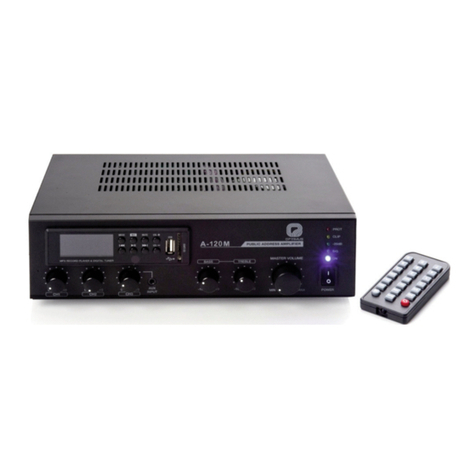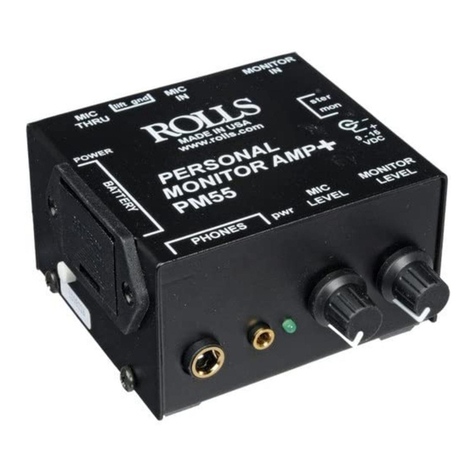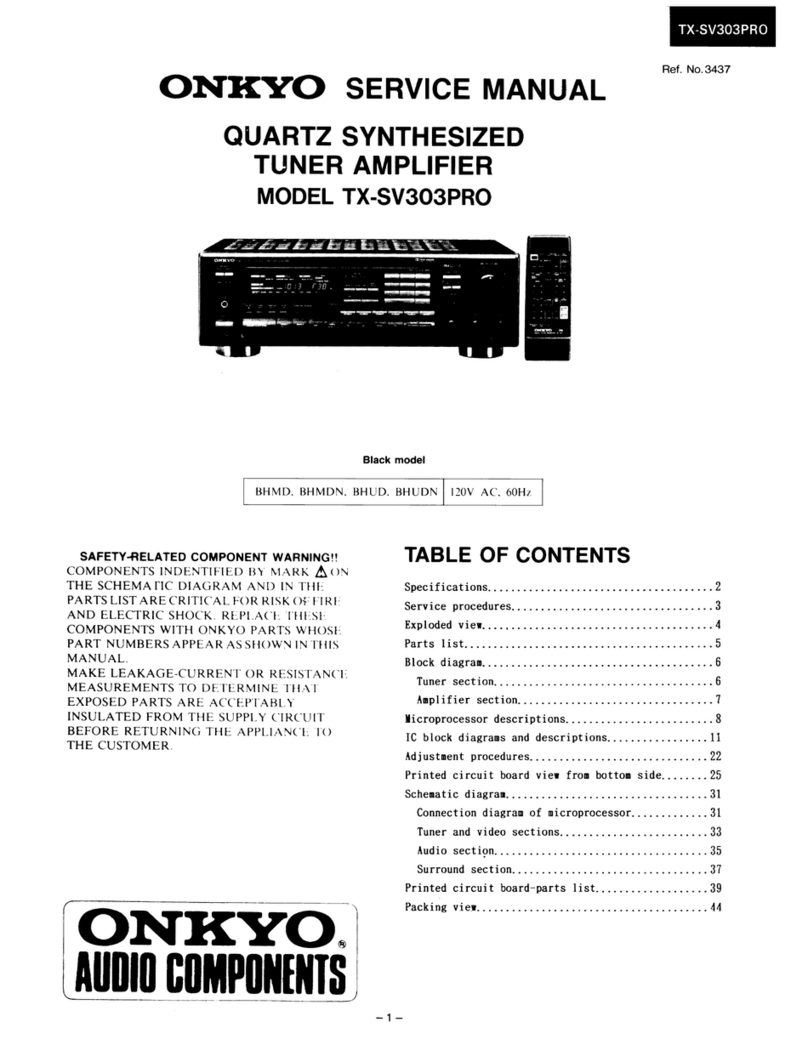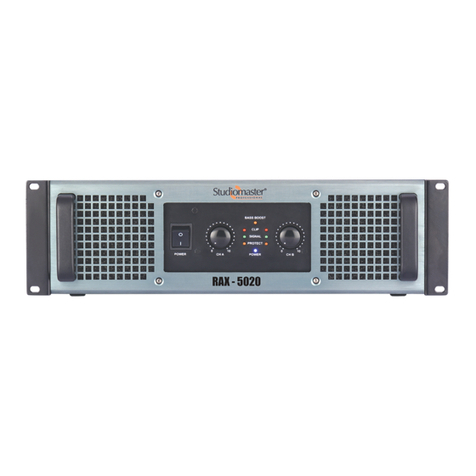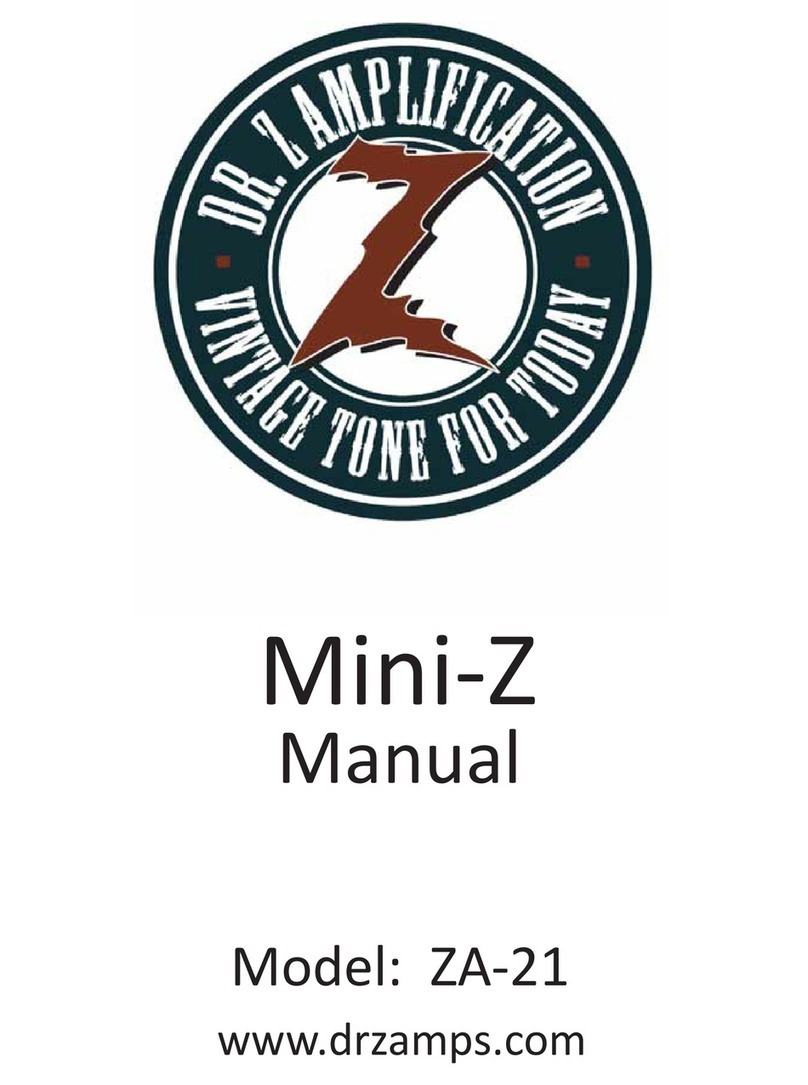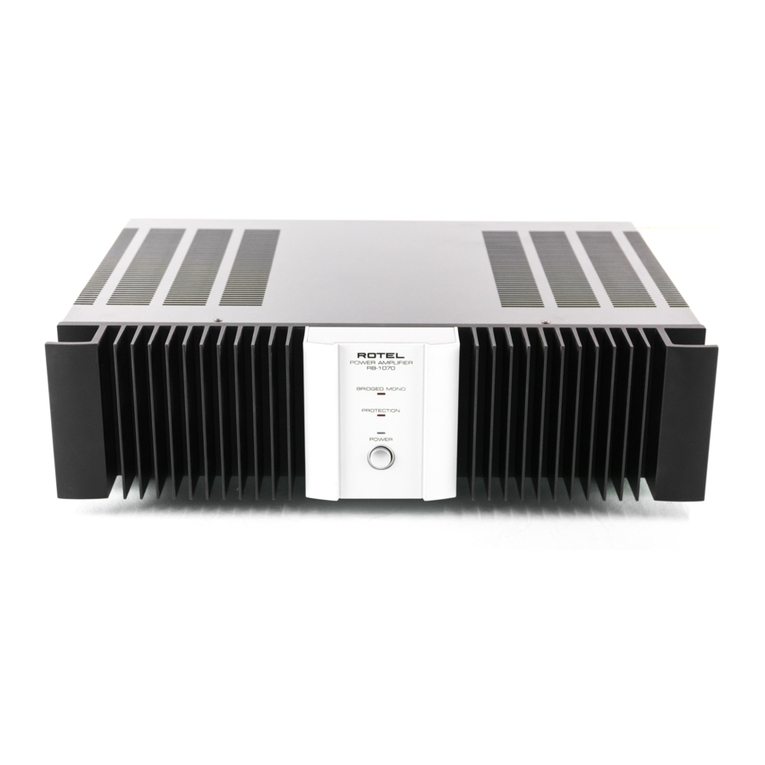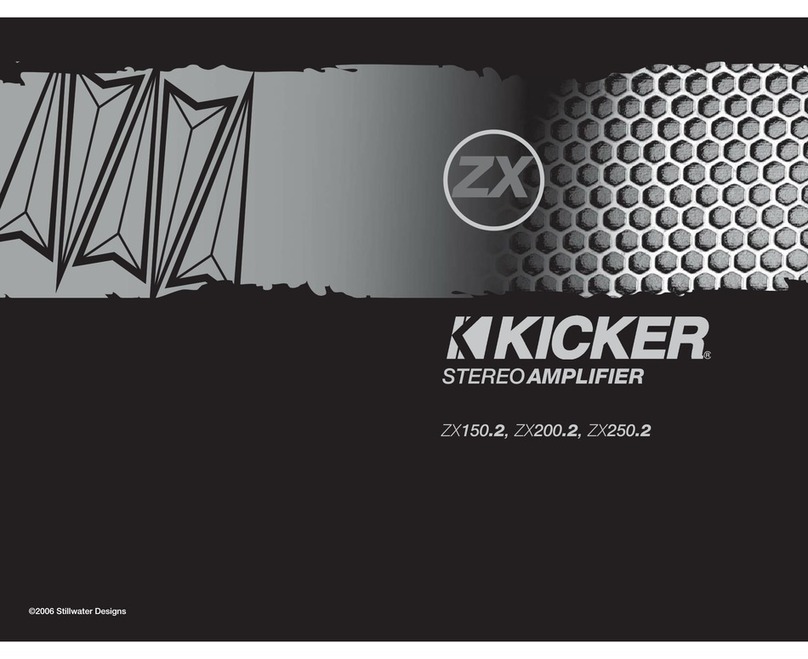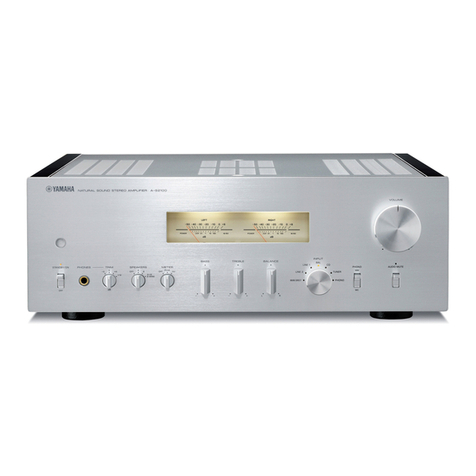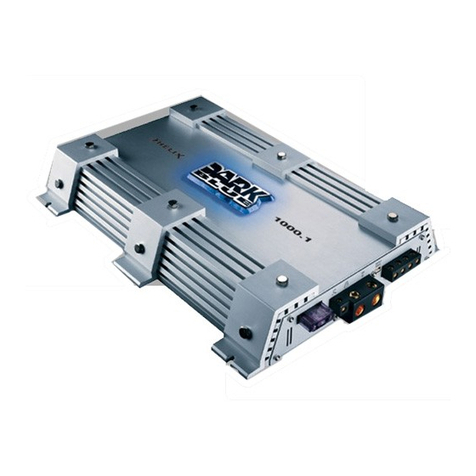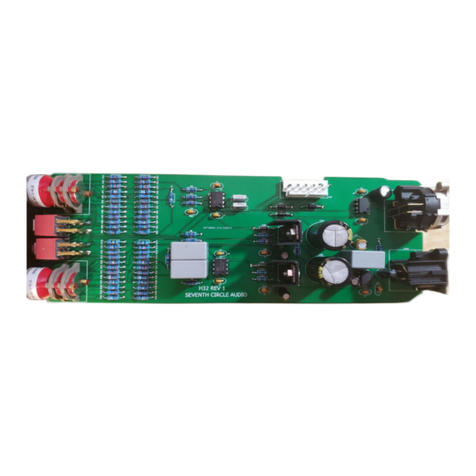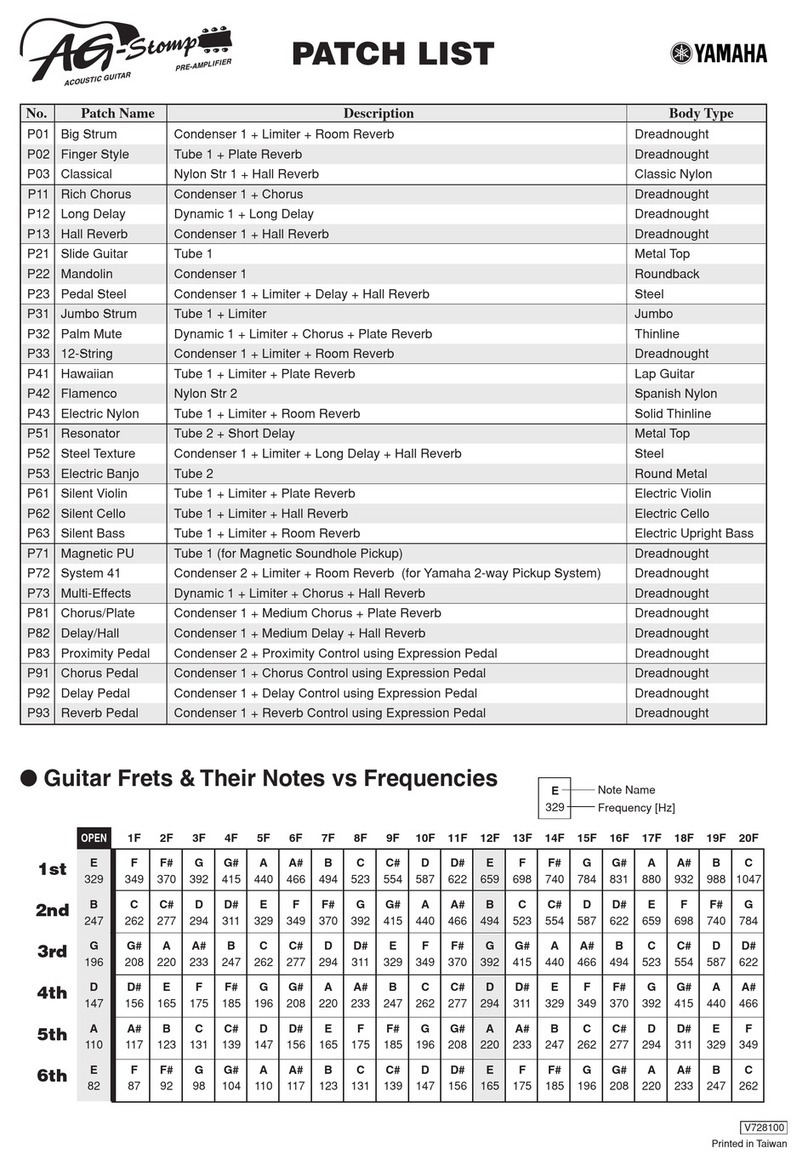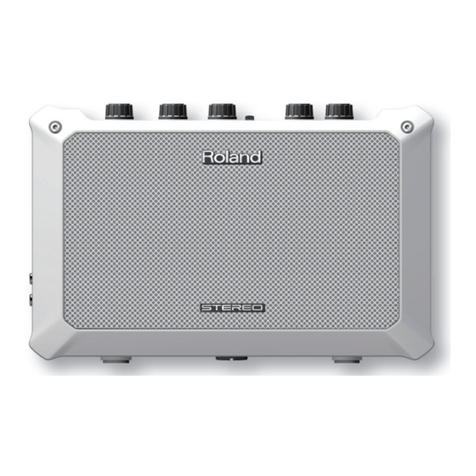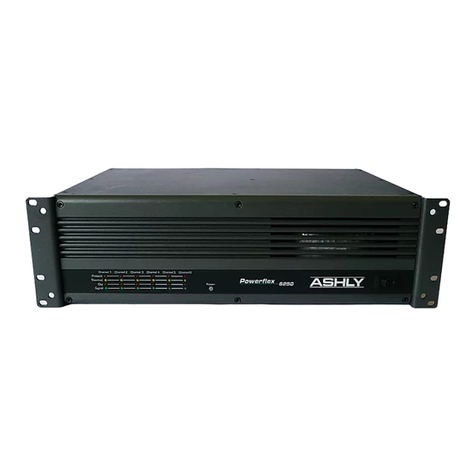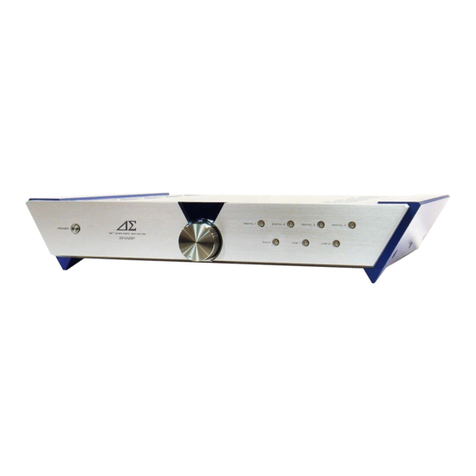Bergantino B AMP User manual

B|AMP™
Owner’s Manual

!
2!
Table Of Contents
Important Safety Instructions ................................................................................ 3
Introduction ........................................................................................................... 4
Quick Start ............................................................................................................ 6
Front Panel Controls and Operation ..................................................................... 8
Rear Panel Controls and Operation.................................................................... 12
Extended Amplifier Features............................................................................... 14
Installation and Maintenance .............................................................................. 21
Specifications...................................................................................................... 22
Warranty Information .......................................................................................... 23
All Features and specifications are subject to change without notice.
This list is subject to change without notice.
WARNING: This amplifier is capable of producing sound pressure levels that may damage
your hearing. Always operate at a safe listening level or use hearing protection if operating at
higher levels.
Bergantino Audio Systems
1 Main Street, Building 12
Whitinsville, MA, 01588
508-234-4195
www.bergantino.com
Manual Version Beta

!
!
3!
Important Safety Instructions
Read these instructions:
Please read all Safety and Operating instructions before connecting and operating this
product. This manual should be kept for future reference.
Verify AC Circuit Capacity Before Use:
Your new Bergantino B|AMP comes equipped with a UPS (Universal Power Supply) capable
of operating from 100 – 240VAC (~), 50/60hz with no user adjustments or switching necessary.
The high power output of your amplifier may require heavy current draw under Full-Load
conditions. Connecting multiple amplifiers to the same circuit, or connecting the amplifier to the
same circuit used by other heavy power devices, such as high-wattage lights, may cause
circuit breakers to trip. It is always a good idea to avoid using any audio equipment on the
same AC circuit as equipment with motors, such as air conditioners or refrigerators. This will
lessen the possibility of power variation and electrical start-up noise affecting your sound.
Earth Grounding Connection:
To prevent electric shock, do not remove the grounding plug on the power cord, or use any
plug or extension cord that does not have a grounding plug provided. Make certain that the AC
outlet is properly grounded as well. Do not use an adapter plug with this product.
Protect the power cord from being walked on or pinched particularly at plugs,
convenience receptacles, and the point where they exit from the apparatus:
To avoid safety hazards, use only the power cord supplied with your unit. We do not
recommend using an extension cord with this product. Damaged power cords should be
replaced immediately with cords meeting factory specifications. If a replacement cord is used,
make certain that it is of consistent quality and gauge as the original and is UL/IEC Certified.
When disconnecting the power cord from an AC outlet, always pull the plug, never pull the
cord. If you do not intend to use the amplifier for a considerable length of time, disconnect the
plug from the AC outlet.
Do not use this apparatus near water:
Never expose the amplifier to rain, moisture, dripping or splashing water. Do not place objects
filled with liquids on or nearby the amplifier.
Do Not Open The Amplifier Enclosure:
There are no user-serviceable components inside this product. Opening the amplifier
enclosure may present a shock hazard, and modification to the product will void your warranty.
If liquid enters the unit, or any metal object such as a piece of wire accidentally falls inside the
enclosure, disconnect the unit from the AC power source immediately and consult an
authorized service station.
Unpacking:
The carton and packing materials used in shipping your new amplifier were specially designed
to cushion it from the shocks and vibration that occur during transport. We suggest that you
save the carton and packing materials for use in shipping, in the event you move, or the
amplifier needs repair.

!
4!
Introduction
Congratulations on your choice of the Bergantino Audio Systems’ B|AMP as your amplifier and
welcome to the Bergantino family! First we would like to thank you for choosing Bergantino
Audio Systems as your amplifier company. This is something we never take for granted. We
are confident that your new amplifier will bring you many years of trouble free use and we feel
that our high quality design and build standards will help you reach your creative goals.
The Bergantino Audio Systems’ B|AMP is an incredibly flexible, state-of-the-art Bass Amplifier,
designed to deliver maximum performance, yet simple to operate. The B|AMP takes a
completely new approach to bass amplification by considering and including the speaker
cabinet’s response and its environment as part of the amplification signal path. No other bass
amplifier on the market has the ability to manage speaker and system performance like the
B|AMP. This is accomplished through our Profile EQ system along with many other important
and useful design features including:
•DSP, Embedded System Controlled, Bass Amplifier
•LCD Display
•Multifunction Tone Controls; 4-Band EQ w/ Adjustable frequency range
oBASS: +/- 9dB Variable from 40hz to 120hz
oLMID: +/- 9dB Variable from 150hz to 800hz
oHMID: +/- 9dB Variable from 800hz to 3khz
oTRBL: +/- 9dB Variable from 3khz to 8khz
•Programmable Filters
oProgrammable bright switch: +3dB to +12dB in 1dB increments, variable from
2khz to 10khz in 500hz increments
oVariable High-Pass Filter (VHPF): Adjustable from 30hz to 80hz in 2hz
increments
oVariable Feedback filter: Adjustable from off to -6dB to -12dB in 1 dB increments.
Frequency range from E1 (41hz) to G3 (196hz) in half step increments
•On-Board Programmable Chromatic Tuner stable down to the low B fundamental
•Auxiliary input and headphone jack for personal monitor and practice use
•Effects send and return loop
•Studio quality Direct Output, software selectable Pre or Post EQ
•Software Selectable Line Output (Pre-amp or tuner out)
•UPS – Universal power supply 115VAC- 240VAC 50/60hz
•Software selectable Phase output (Normal or Reverse)
•2 User Programmable Memory Settings
•USB Port
oLoad Custom Speaker Profiles
oSoftware Upgradable
oExpandable System Architecture
•Power Section: 700W RMS at 4-Ohms, 800W RMS at 2.67-Ohms and 800W RMS at 2-
Ohms
oSoftware selectable, speaker impedance matching for optimal power transfer
down to 2-Ohm minimum load.

!
!
5!
Speaker Profiles = Intelligent Equalization:
Having your speaker cabinet EQ’d and matched to the acoustic environment frees up your
tone controls to be creative elements, rather than being used to ‘fix’ a speaker design or a bad
acoustic space.
Cool Running = Reliability:
The B|AMP uses a Class D amplifier topology that generates less than half the heat of
conventional amplifiers. This keeps the amp running a lot cooler and makes it much more
reliable. To cool the amp when it’s being driven hard, we’ve incorporated a temperature
sensitive fan cooling system. When the amp is under a light load, the fan is off. If the amp
should reach a specified operating temperature, the micro-controller in the B|AMP will turn the
fan on automatically until it is cooled to a safe operating temperature. This type of thermal
management will ensure years of trouble free use.

!
6!
Quick Start
The Bergantino Audio Systems’ B|AMP is designed to be incredibly flexible, yet simple to
operate. All controls have a well-defined purpose and are designed to be as intuitive as
possible. These directions will help take you through the basics and give you a good start for
setting up your sound, especially if you own a currently available, Bergantino speaker cabinet.
However, it is highly recommended to read on to learn all the features of the B|AMP in order to
realize all its very useful features and benefits!
1. Plug the B|AMP in:
With the power switch in the Off position, connect the supplied power cord from the amplifier
AC receptacle, to an AC power outlet of proper voltage and power rating (see safety
information for more details).
2. Connect your speaker cabinets:
Connect your speaker cabinet(s) to either of the SpeakOn outputs (these are wired in parallel
so you can use either one). Be sure not to exceed the minimum recommended speaker load.
The minimum recommended speaker loads for the B|AMP is user programmable in the
software program menus for 2-Ohm, 2.67-Ohm and 4/8-Ohm operation. The initial default
setting is 4/8-Ohm.
3. Plug in your bass:
Using an instrument cable, connect your bass to the Input jack and turn the power switch on. If
you have active tone controls on your bass, turn all of the controls to the middle or flat position
and adjust the volume to the maximum point you would normally use. If you have a passive
bass, turn all tone and volume controls all the way up.
4. Front panel control settings:
When you first turn on the B|AMP the tone controls will be set flat and no speaker profiles will
be installed. Set the Instrument Gain and Master Volumes at 0 (off).
5. Select Speaker Profile
If you’re using a currently offered Bergantino speaker model, push the Prog button to the right
of the LCD display until your speaker model appears on the display.
The screen below shows the CN212 profile being selected by pressing the Prog button from
the home screen until CN212 appears on the LCD display. The CN212 profile is now loaded
into the B|AMP’s Profile EQ section.
If you’re not using a currently offered model, you can download the profile for many of our
older, discontinued Bergantino cabinets as well as some Bergantino cabinet combinations from
our website (www.bergantino.com) onto a FAT32 formatted thumb drive, and load it into one of
the 12 dedicated Profile memory slots via the USB port (see Profile Menu below).

!
!
7!
!The currently selected Profile will be loaded into the DSP profile filters
upon each recycling of power until a new one is selected.
6. Input level and Master Volume settings:
For proper operation, it is very important to adjust the Input gain level properly. To adjust the
input level, first turn the Master volume of the B|AMP all the way down (CCW). Next, with the
Input gain knob also all the way off (fully CCW), put the volume controls of your instrument at
the maximum level you will be using them at and then play your bass like you normally would
(including your hardest dynamic attacks). Increase the Input Gain control (clockwise) until the
OL (overload) indicator just begins to flash. Reduce the Input Gain (CCW) by a 1/8 of a turn to
give you some added headroom. If using a passive bass, and the OL doesn’t come on at all
with the gain turned all the way up, that’s ok as long as you can achieve your overall desired
volume with the Master volume. However, depending on your instrument’s overall output level,
you may need to increase the input gain of the B|AMP. Learn how to adjust the B|AMP’s Input
gain in the Extended Amplifier’s Feature section under Program Mode.
Important!: If using an active bass and the Input gain level of the B|AMP is near or below 9:00
in order to keep the OL led from flashing, it is highly recommended you turn down the volume
on your bass, or preferably, if so equipped, turn the gain down on your onboard preamp. This
is very important as to not overdrive the input of the B|AMP. Some onboard preamps have
internal adjustable gain controls. If you have active/passive switching capabilities on your bass,
it is best to adjust these gains such that the passive and active output levels are the same with
the tone controls set flat. In other words, you want to adjust your onboard preamp to have unity
gain with all tone controls flat. This will ensure maximum headroom for you onboard preamp as
well as best gain matching of your bass to the B|AMP’s input stage.
!Remember, the purpose of an onboard preamp is to buffer the pickups from long cable
runs and to provide active tone controls for tone shaping, not to increase your overall
output level and volume. That is what your amplifier is for!
Once you’ve matched the maximum signal from your bass without overloading the input stage
of the amplifier, increase the Master volume of the B|AMP by turning the Master volume
control in a clockwise direction to the desired level. You should be hearing your bass quite well
at this point. You should now only use the Master volume now to achieve your desired sound
level.
!For clear, undistorted sound, it’s very important not to overdrive the input stage of the
B|AMP. If you increase in level any tone or volume control on your bass after adjusting
the input gain, you should check to make sure the OL indicator isn’t flashing.

!
8!
Front Panel Controls and Operation
1. Aux Input:A standard 1/8” mini stereo jack to plug in an external sound source (iPod, MP3
player, etc.). The Aux Input does not go to the DI. Maximum, unclipped input level is 2Vrms.
2. Aux Gain: Gain control for the Aux input device. Adjust this knob to achieve the desired
level of your Aux Input source and to obtain the relative balance between this source and your
instrument. If the OL indicator illuminates, turn down Aux Gain level on B|AMP until it no
longer flashes. If it still flashes with level all the way down, turn level down from device
connected to Aux input and then readjust Aux Gain level.
3. Input:A 1/4” unbalanced input jack to plug in an active or passive bass into a studio quality,
high impedance, input buffer.
4. Input Gain:Gain control for the Instrument input. Adjust this level to obtain maximum input
gain before any flashing of the OL indicator occurs.
5. OL (overload) Indicator: Indicates the input stage of the B|AMP is being overdriven when
flashing yellow. If an overload condition is indicated, turn appropriate gain knob (Aux or Input)
counterclockwise to reduce gain until no flashing occurs and adjust Master volume to achieve
desired volume. Also learn more about properly adjusting the Input gain of the B|AMP in the
Input Gain section of the Program Mode part of this manual.
6. Master (volume): This control raises and lowers the Master volume of the B|AMP.
7. Protect (indicator): Should the amp experience a fault (over heat, over current) the amp
will mute the output and this LED will turn red until the condition is corrected. Check and make
sure there are no obvious conditions causing the amp to enter protect mode such as a shorted
speaker cable or the fan or vent holes being blocked on the outside of the unit.

!
!
9!
8. Clip (indicator): This indicator will flash yellow when the B|AMP senses an overdriven or
clipped signal at its output. This is an indication that the amplifier is being driven beyond its
ability to produce a clean, undistorted output signal. It’s ok and normal to see the flashing of
this indicator on loud peaks. However, continuous, sustained illumination of this indicator
should be avoided.
!There are Proprietary and very musical Compressor/Limiters programmed into the
B|AMP’s DSP to help prevent the B|AMP from being overdriven to a point of audible
distortion.
9. LCD Display: The LCD (liquid-crystal display) display serves many functions and displays
everything from basic tone control settings (home screen) to the many levels of software based
menu screens in the B|AMP.
10. BASS/Filters Control: This control has multiple functions:
As a Tone Control, turning the control Left or Right from the home screen will decrease or
increase the level of the Bass frequencies in 1dB increments, from -9db to +9db. The level in
dB will be shown above on the LCD display.
!The screen below shows an example of the B|AMP’s home screen where the gain of all
4 tone controls can be adjusted.
If you push and hold the BASS/Filters control for 2 seconds, you will be able to adjust the
center frequencies of all 4 tone controls. The frequency range of the Bass control is from 40hz
to 120hz, variable in 5hz increments. You can return to the home screen by pressing any of
the 4 tone control knobs, or if left idle for 5 seconds, the LCD display will return to the home
screen automatically.
!The screen below shows the B|AMP’s semi-parametric EQ screen after pressing and
holding any of the 4 tone controls for 2 seconds.
When the BASS/Filters control is pressed and released, it displays the filter’s screen that
includes a VHPF screen (Variable High Pass Filter) and Variable Feedback filter.

!
10!
The VHPF (turn BASS/Filters knob to adjust frequency) allows frequencies above the
displayed frequency to pass while cutting frequencies below. Factory default is 40hz. Turning
this knob adjusts the cut-off frequency from 32hz – 80hz in 2hz increments. Use this control to
clean up the very low end of the bass frequencies, which can often muddy the low-end
program information and needlessly stress your speaker system and waste amplifier
headroom.
!To help minimize needless stress on speakers and maximize amplifier and overall
system headroom, it is advisable to set this control at 40hz (factory default setting) or
higher, if further low frequency attenuation is needed.
The Variable Feedback filter is intuitively designed to help you identify and sweep the note
frequencies from E1 (41hz) – G3 (196hz) in single note (1/2 step) increments, and adjust the
gain from OFF to -6db to -12dB in level to help eliminate or minimize problem feedback issues
with electro-acoustic instruments.
To use, try to identify the note on your instrument that is feeding back the strongest from the
location in which you will be playing (very important as feedback is affected by the
proximity of the instrument to the boundaries and music source in which it is near). While
muting your instrument or amp, press and release the filter knob and then turn the LMID or
HMID knob to the note (i.e. E1) that is feeding back the strongest. Turn the TRBL knob CCW
to set the cut level between -6db and -12db, then un-mute the amp or instrument and go back
to the same location you will be playing from and see if the feedback has been eliminated or
reduced. You may need to try this a few times and adjust the amount of cut in gain
accordingly.
!The Variable Feedback filter’s parameters are not saved in Mem1 or Mem2 and is
reset to OFF on power recycle, as it is an environment dependent adjustment.
!The green Filters LED indicates that either one or both of the filters are engaged.
11. LMID/Mem1 Control: This control has multiple functions:
As a Tone Control, turning the control Left or right from the home screen will decrease or
increase the level of the LMID frequencies in 1dB increments, from -9db to +9db. The level in
dB will be shown above on the LCD display.
Push and hold this control for 2 seconds, and you will be able to adjust the center frequencies
of all 4 tone controls. The frequency range of the LMID control is from 150hz to 800hz, variable
in 50hz increments. You can return to the home screen by pressing any of the tone controls, or
if left idle for 5 seconds, the LCD display will return to the home screen automatically.
If a tone setting has been previously stored in this location, when pushed and released, that
tone setting will be loaded into the DSP’s tone filters, including the state of the bright switch.
(See Mem1/Mem2 save on how to save settings to this location). Push this knob again, and

!
!
11!
you will be taken back to the previous home screen.
12. HMID/Mem2 Control: This control has multiple functions:
As a Tone Control, turning the control Left or Right from the home screen will decrease or
increase the level of the High-Mid frequencies in 1dB increments, from -9db to +9db. The level
in dB will be shown above on the LCD display.
Push and hold this control for 2 seconds, and you will be able to adjust the center frequencies
of all 4 tone controls. The frequency range of the High-Mid control is from 800hz to 3khz,
variable in 100hz increments. You can return to the home screen by pressing any of the tone
controls, or if left idle for 5 seconds, the LCD display will return to the home screen
automatically.
If a tone setting has been previously stored in this location, when pushed and released, that
tone setting will be loaded into the DSP’s tone filters, including the state of the bright switch.
(See Mem1/Mem2 save on how to save settings to this location). Push this knob again, and
you will be taken back to the previous home screen.
13. TRBL/Bright Control: This control has multiple functions:
As a Tone Control, turning the control Left or Right from the home screen will decrease or
increase the level of the Treble frequencies in 1dB increments, from -9db to +9db. The level in
dB will be shown above on the LCD display.
If you push and hold this control for 2 seconds, you will be able to adjust the center
frequencies of all 4 tone controls. The frequency range of the treble control is from 3khz to
9khz, variable in 500hz increments. You can return to the home screen by pressing any of the
tone controls, or if left idle for 5 seconds, the LCD display will return to the home screen
automatically.
When this control is pressed and released, it activates the Bright Control. This control is a
peaking filter. Use this control to add some sparkle or snap to your final tonal contour and to
add or remove edge and definition. (See Bright Adjust Menu in program mode on how to
program the frequency and gain of this filter)
14. Prog (Program Button): From the home screen mode, push the Prog button once to see
which profile is currently loaded into the DSP, then, before the screen times out, continually
push the Prog button until the profile name of the desired speaker appears on LCD display.
The displayed Profile’s EQ will be loaded into Profile EQ section of DSP. The display will
eventually time out and return to the home screen. Press and hold for 3 seconds to enter
program mode. Green Prog LED will illuminate. (See Program Mode).
15. Mute: When Mute is engaged, the red Mute LED will illuminate and the amplifier’s Main
output, DI output, and Line output (except when tuner is selected for the Line out) will be
muted.
If the B|AMP’s tuner is disabled (see Tuner section in Program Mode), the screen below will
be shown on the LCD display.

!
12!
If the B|AMP’s tuner is enabled, a fully digital chromatic tuner is activated and displayed on the
LCD display.
The first screen indicates there is no signal detected by the B|AMP’s tuner. The second
screen indicates a properly tuned A1 string. The third and fourth screens show a sharp F#2
and a flat G2 respectively.
16. USB Port: This port will support a FAT32 formatted thumb drive to load speaker profiles
into program memory and also perform firmware updates.

!
!
13!
Rear Panel Controls and Operation
1. Power Switch: Turns the amplifier on or off.
2. AC Receptacle: The power cord is detachable and plugs in here.
3. Line (output): This output is software selectable in Program Mode. It can be programmed
as a preamp out (post Master volume), or it can be programmed as a tuner output. This
connecter is a ¼” unbalanced output. The default setting is Pre-Amp out.
4: Headphone (output): 1/4” Stereo headphone jack designed to drive full-range headphones.
5. Effects Send: Unbalanced 1/4” connector used when sending a full range, instrument level,
mono signal to an external device (effects, processors, etc.).
6. Effects Return: Unbalanced 1/4” connector that accepts an instrument or line level return
from external effects that are connected in a “series loop”. It has a 1Vrms max. input level. If
the OL LED illuminates, turn down levels from previous gain stages in the signal chain.
7. Ground Lift: This switch disconnects the ground on the balanced Direct Out, XLR output to
eliminate hum and buzz when the amplifier is connected to equipment that is running on a
different ground system.
8. Direct Out: Studio quality DI sends an electronically balanced output signal eliminating the
need for an external DI. This output can be selected to be PRE- EQ or POST- EQ (software
selectable in Program Mode). The DI out is 48V phantom power protected.
9. Speaker Outputs: Parallel SpeakOn output connectors (Neutrik NL4 1+/1-). The minimum
recommended speaker load for the B|AMP is user programmable down to a 2-Ohm minimum
load. See Program Mode section for setting up the B-AMP for proper impedance matching. A
minimum of 16awg speaker cable is highly recommended.

!
14!
10: Cooling Fan: The onboard microcontroller monitors the amplifier temperature and
engages the cooling fan when needed to reduce the amplifier temperature. The fan can be
turned from Auto to On in Program Mode for extreme usage conditions.
Note: The fan is automatically set to Auto upon each power recycle.
Extended Amplifier Features
Mem1/Mem2 Save
You can save and store 2 independent tone settings in memory for future recall. The
parameters that are saved are the BASS, LMID, HMID, TRBL (center frequency and gain), and
Bright settings.
Once you’ve determined the tone setting you want to save, while pressing and holding the
Prog button, press the desired Mem location where you would like to store that tone setting
(Mem1 or Mem2). The LED over that memory location will illuminate indicating the tone setting
is now saved in that Mem location.
To recall these setting at a later time, just push the appropriate Mem control knob and release.
The saved settings will now be loaded into the DSP and the green LED will illuminate. To go
back to the previous home screen, just push the same Memory control knob again.
Program Mode
Many of the B|AMP’s extended and unique features are accessed in the program mode. To
enter program mode, press and hold the Prog button for 3 seconds. The green Prog LED will
turn on and the first menu screen will appear on the LCD display (Input Gain Menu). The
green Prog LED will stay on for the duration of the time you’re in program mode. By quickly
pressing and releasing the program button while in program mode, you will be able to cycle
through the various program menus until you reach the desired menu(s). To leave program
mode and go back to the home screen, press and hold the Prog button again for 3 seconds, or
the Program mode will eventually time out to the home screen after approx. 10 seconds of no
activity.
Screen 1 – Input Gain menu
This menu allows you to select between Normal and +6dB (x2) input gain levels.
Turn the BASS/Filters Knob to select the desired Input Gain level:
Normal "+6dB

!
!
15!
Properly Adjusting Input Gain
If you’re using an active bass, you should always be in Normal mode (Factory default setting).
If you’re using a passive instrument, start in Normal mode first to determine if you need to
increase input gain. With the Master volume all the way off, and your instrument’s volume
controls at the maximum level you intend to use them at, play your instrument as you normally
would, including your hardest dynamic attacks. Turn the Input gain knob CW until the OL
indicator flashes, then back the gain off about 1/8 of a turn for added headroom.
Note: If you can’t turn the input gain knob CW past 9:00 without the OL indicator flashing, turn
the volume down on your bass, or, if your bass has a gain adjustment on its onboard preamp,
turn that gain down first. Failure to do so could allow the input stage of the B|AMP to be
overdriven, limiting the dynamic range of your signal and creating unnecessary distortion. In
addition, if the output of your active bass is too hot, you could unnecessarily and unknowingly
be clipping your onboard preamp, introducing a distorted signal to your amplification system
right out of the gate! Try to adjust your bass’ active output level to be the same as its passive
level to ensure maximum dynamic range and headroom before clipping.
!It can’t be stated often enough that the sole purpose of having active electronics on
your instrument is not to increase its overall gain or output volume, but to buffer your
pickups from long cable runs and to give you the flexibility of tonal adjustments at your
fingertips!
If using a passive bass and the OL indicator doesn’t flash with the Input gain turned all the way
up, and you can’t obtain your desired volume without the Master volume exceeding 2:00, you
should select the +6dB setting for that particular instrument. Otherwise it’s perfectly acceptable
with a passive instrument to have the Input gain turned up all the way in Normal mode.
Screen 2 – DI Select menu
This menu allows you to select whether the Pre EQ or Post EQ signal is sent to the DI output.
•Turn the BASS/Filters Knob to select DI Output:
Pre-EQ "Post- EQ
Pre-Eq: This signal includes input gain and effects loop, but no tone controls
Post-EQ: This signal includes input gain, effects loop and tone controls.
!The B|AMP’s Profile EQ section will never go to the DI!output, thus never to the FOH
system. This is an important feature of the B|AMP’s architecture, as it allows the
profiles to properly EQ your stage system without interfering with the FOH system. Your
Post EQ DI contains only your tone adjustments, not your speaker EQ!

!
16!
Screen 3 – Bright Filter Adjust Menu
This menu allows you to adjust the center frequency and gain parameters of the Bright filter.
When the bright function is engaged from the home screen by pushing the Bright control knob,
the parameters you adjust in this menu will be loaded into the DSP’s Bright filter.
!Be sure to engage the Bright function while in the home screen before entering
program mode so you can test the results of your adjustments in real time while in this
screen.
•Turn the BASS/Filters knob to adjust frequency from 2khz to 10khz in
increments of 500hz.
•Turn the TRBL/Bright knob to adjust gain in increments of 1dB from
+3dB to +12dB.
Below shows the Bright filter adjusted to a center frequency of 4.5khz and a gain of +6db.
Whenever the Bright function is engaged from the home screen, these parameters will be
loaded into the B|AMP’s Bright filter EQ.
Screen 4 – Profile Menu
This menu allows you to load new profiles from a FAT32 formatted thumb drive into one of the
twelve dedicated Profile memory locations of the B|AMP. In this menu the B|AMP will read
any file off the thumb drive with a .PRF extension. You will be able to scan and select which
speaker profile you would like to import from the thumb drive and choose which dedicated
profile memory location you would like to store it in for future recall. You can overwrite profiles
already stored in the B|AMP with new ones, if need be. Once stored and power is recycled,
you will be able to load this profile into the DSP’s profile filters from the home screen by
pressing the Prog button until the name of the desired profile is indicated on the LCD display.
To load speaker Profiles:
•Insert thumb drive loaded with .PRF files into B|AMP’S USB port
•Turn the BASS/Filters knob to select Profile on your USB thumb Drive
you want to store in memory
•Turn the TRBL/Bright knob to select which memory location to store the
profile
•Press any knob to Store Profile.
The first screen below shows the software prompting the user to insert a USB thumb drive into
the B|AMP’s USB port in order to load a new speaker Profile (*.PRF file). The second screen
shows the CN212profile being loaded into memory slot 3 of the B|AMP’s profile memory.

!
!
17!
!Once loaded into one of the twelve B|AMP’s Profile memory slots, the new
speaker profile can be loaded into the B|AMP’s Profile EQ filters from the home
screen by pushing the Prog button until the new speaker profile’s name appears
on the LCD display.
!Important! After loading the desired profile(s) and removing thumb drive from
USB port, you must recycle power.
Screen 5 – Line out Select
This menu allows you to select which signal is routed to the line out jack on the back of the
B|AMP. You have 2 choices, the preamp out signal (which is post Master volume), or tuner
out, which will allow you to hook up your own tuner to the Line out jack and receive an
unprocessed signal from the input stage of the B|AMP.
•Turn BASS/Filters Knob to select Line out
Pre-Out "Tuner
Note: If Tuner is selected, this output will not be muted when the B|AMP’s Mute function is
engaged, allowing music signal to pass to a user supplied tuner during system muting. If Pre-
Out is selected, this output will be muted along with the B|AMP’s Main and DI outputs.
Screen 6 – Speaker Impedance Select
This menu allows you to condition your B|AMP to be safely used with various speaker loads. It
can select between 4/8-Ohm, 2.67-Ohm and 2-Ohm loads. The 4/8-Ohm setting is the
default setting and should be used for both 4 ohm and 8-ohm speaker loads.
**Warning! Selecting an impedance higher than the one plugged into the B|AMP can cause
the amp to enter protect mode, reducing the output level of the amp or muting the output all
together until the underlying condition is rectified.
!Conversely, selecting an impedance lower than the one plugged into the B|AMP will
limit you from utilizing the B|AMP’s full power capabilities.
Be sure to calculate your speaker impedances properly!
4-Ohm = 1 x 4-Ohm or 2 x 8-Ohm;
2.67-Ohm = 1 x 8-Ohm +1 x 4-Ohm or 3 x 8-Ohm;
2-Ohm = 2 x 4-Ohm or 4 x 8-Ohm

!
18!
•Turn BASS/Filters knob to select desired Impedance
4/8 Ohm "2.67 Ohm "2 Ohm
!Below are three screens indicating the impedance options of the B|AMP.
!When 2 Ohm operation is selected, the fan is automatically engaged.
Screen 7- Main Phase Menu
This menu allows you to reverse the phase of the main amplifier’s output (including pre-out, if
selected as the line out) to help eliminate any possible feedback or phasing issues
experienced in a live or recording environment. It does not affect the phase of the DI out.
•Turning the BASS/Filters knob
Normal "Reverse
Screen 8 – Tuner Frequency, Instrument Select and Enable Menu
This menu allows you to choose the A4 reference frequency for instrument tunings. Ranges
from A432 – A448 can be selected using the BASS/Filters knob.
It also allows you to optimize the tuner’s speed and accuracy for either Bass or Guitar by
turning the LMID/Mem1 knob to the desired instrument. And, you can enable or disable the
tuner function in this menu by turning the TRBL/Bright knob to the desired selection. If
enabled, when Mute is engaged, the LCD display will turn into a very fast and accurate
chromatic tuner optimized for the instrument selected.

!
!
19!
!The factory default is A=440.
Screen 9 – Fan Menu
This menu allows you to select Auto or On for fan control. Although not recommended, it can
be useful if you’re playing an outside venue in direct sunlight such that the case temperatures
can get unusually warm just by the effects of the direct sun. Turning the fan on will keep air
circulating through the case minimizing any heating issues under these extreme conditions.
Auto only turns the fan on when a specified temperature is reached and is the default setting.
It will be selected automatically upon power up.
•Turning BASS/Filters knob
Auto "On
!The fan is automatically engaged when 2-ohm operation is selected.
Screen 10 – Contrast Adjust Menu
This menu allows you to adjust the contrast of the LCD Display.
•Turn BASS/Filters knob to adjust contrast

!
20!
Screen 11 – Factory Reset Menu
This menu allows you to return to original factory settings.
•Turn BASS/Filters knob until a 1 appears in first position.
•Turn LMID/Mem1 knob until a 2 appears in the second position.
•Turn HMID/Mem2 knob until a 3 appears in the third position.
•Turn TRBL/Bright know until a 4 appears in the fourth position.
•Press any knob to return to original factory settings.
!This reset will NOT erase any stored Speaker Profiles in the B|AMP’s memory, nor will
it erase any stored user memory settings.
Screen 12 – Software Rev. Menu
This menu displays the current version of the software loaded into your B|AMP.
It will also be displayed upon power up on the welcome screen menus.
Firmware Upgrade
If new software becomes available for your B|AMP, you can upgrade the firmware via the USB
port by doing the following:
•Load the firmware *.hex file onto a FAT32 formatted thumb drive.
•Rename the file to Bampfw.hex
•With the B|AMP’s power off, insert the thumb drive into the USB port
•While holding the PGM button in, turn the B|AMP on and continue to hold the PGM
button in until the PGM led starts flashing.
•Once the Home screen appears on the LCD display, remove thumb drive and recycle
power.
•Your new software is ready to go!
Table of contents
Other Bergantino Amplifier manuals


